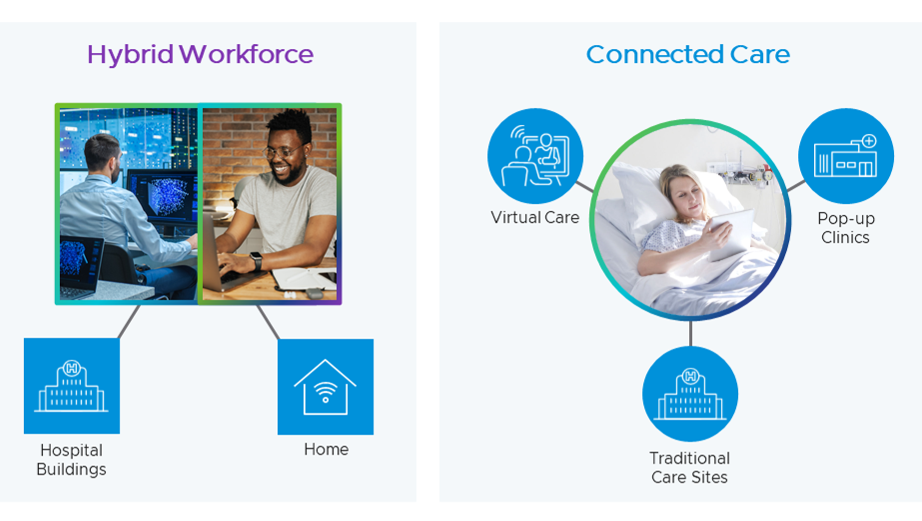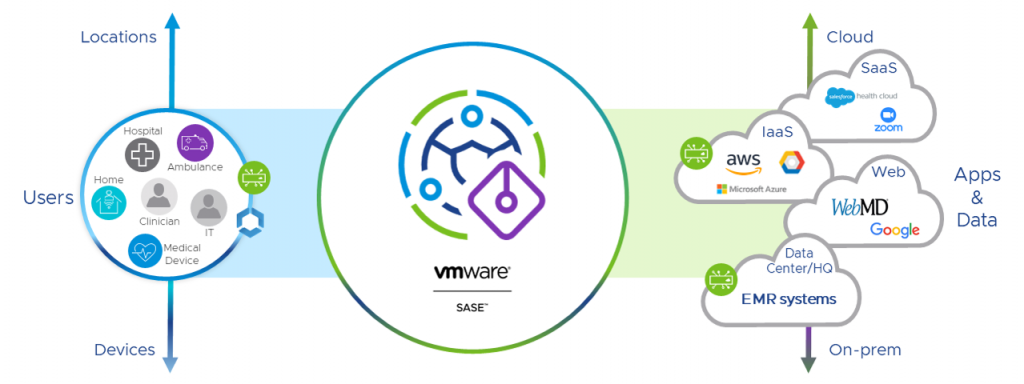The spread of COVID-19 is slowing in the U.S., but its effects on business and healthcare remain. For example:
- Patient preferences have changed. In 2019, only 11% of patients opted in to telehealth services. That number is projected to rise to 76%.
- Many healthcare workers have left the profession because of burnout, causing staffing shortages and increasing stress on the employees who remain.
- Pandemic readiness, including the ability to rapidly set up and tear down pop-up clinics and vaccination sites, continues to be critical to deal with new waves of infection.
Digital-first healthcare, a model that covers the hybrid workforce and connected care, can help meet these needs and more. To help hire and retain workers and encourage productivity, hospitals, clinics and other healthcare businesses must enable employees to work from anywhere. Connected care delivers easy, secure access to care for patients by connecting distributed care sites, rapidly bringing up new care sites if needed, and ensuring that patient information is quickly accessible, always available, and protected. (Learn more about how VMware helps healthcare customers set up COVID-19 testing and care sites in our blog, Three Remote Healthcare Networks in One Day: VMware SD-WAN Is That Fast and That Easy.)

Legacy networking and security technologies can prevent the adoption of digital-first healthcare. Barriers include:
- Unstable, slow connections: Remote workers using best-effort links can experience problems connecting to the Internet and VPNs. Organizations also find it difficult to extend the same level of protection to remote workers as they do to on-site workers. Organizations often backhaul traffic though a data center to apply security, which slows access to cloud-based apps and lowers productivity.
- Poor patient experience: When healthcare professionals have inconsistent access to applications and data across care sites, it is more difficult to deliver new services such as telehealth, and respond to the changing needs of patients. These unnecessary delays reduce the quality of care and have a negative effect on patients’ experience.
- Increased risk: The evolving threat landscape makes it difficult for healthcare providers to safeguard patient data against damaging data breaches and data theft. There is also increasing pressure to meet regulatory compliance requirements such as HIPAA.
- Complex IT operations: Siloed networking and security infrastructure increases costs and complexity to deploy and manage services. In addition, limited resources and skill gaps make it difficult to deliver healthcare IT services.
VMware SASE delivers fast, reliable, secure access for connected care
VMware SASE™ is a cloud-native platform that consolidates networking and security to deliver secure, optimized and predictable access for connected care and the hybrid workforce. It’s simple for remote employees to get VMware SASE wherever they are working.
VMware SD-WAN™, a service of VMware SASE, is quick and easy to set up in any location, from hospitals to ambulances to homes to remote clinics. VMware SD-WAN can use any available connection, including cellular, satellite, broadband, or MPLS, to set up high-throughput connectivity with assured app performance, real-time monitoring and zero-touch deployment—eliminating network issues and extending the same level of protection as onsite employees have.
When remote healthcare workers access cloud or SaaS apps, VMware SASE services use a unique global network of more than 3,000 cloud gateways across 150+ SASE points of presence (PoPs) from VMware and its partners around the world. These provide faster response time and better performance, protect networks from attacks, and protect users from threats and compliance violations.

SASE can help deliver critical healthcare outcomes, including:
- Empower hybrid workers: With VMware SASE services, remote employees can get the same assured performance, security, and application availability as onsite employees, across cloud and the data center.
- Improve patient experience: Clinicians and staff at any location can get consistent and predictable access to critical patient data even if it requires high bandwidth. Assured application performance for communication apps means frictionless telehealth visits even from a remote site, improving patient experience.
- Mitigate risk and ensure compliance: Safeguard your patient data, prevent data loss from breaches and cyber threats, and meet stringent regulatory and compliance requirements such as HIPAA and PCI with comprehensive security delivered from the cloud.
- Simplify IT operations: Eliminate networking and security infrastructure silos. Simplify operations and reduce costs by performing all your networking and security operations from a single unified cloud-hosted management platform. Gain insightful analytics on your hybrid worker user experience.
VMware SASE at HIMSS 2022
See VMware SASE in action at booth 2121. Speakers and times may change, so stop by the booth for the latest schedule.
Check out our demos:
- Hybrid workforce demo shows how remote work experience is made easier, more reliable, more secure, and more productive.
- Connected care demo shows how you can deliver easy, secure access to care for patients by connecting distributed care sites, and ensuring that patient information is quickly accessible, always available, and protected.
Booth theatre sessions are scheduled to include:
- GE Healthcare and VMware panel discussion: Enable Faster, Safer, and More Convenient Virtual Care from Anywhere
- Alla Woodson, General Manager, GE Healthcare
- Paul Jones, Global Product Director, GE Healthcare
- Abe Ankumah, VP Product Management, VMware SASE
- VMware SASE: Enable Digital-First Healthcare Outcomes
- Abe Ankumah, VP Product Management, VMware SASE
- Deliver Patient-Centric Care from Anywhere with VMware SASE
- Brady Kachapuram, Senior Product Marketing Manager, VMware SASE







